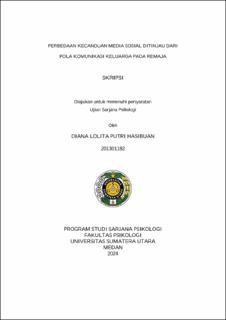| dc.contributor.advisor | Nasution, Indri Kemala | |
| dc.contributor.author | Hasibuan, Diana Lolita Putri | |
| dc.date.accessioned | 2025-03-04T06:10:36Z | |
| dc.date.available | 2025-03-04T06:10:36Z | |
| dc.date.issued | 2024 | |
| dc.identifier.uri | https://repositori.usu.ac.id/handle/123456789/101766 | |
| dc.description.abstract | This study aims to identify differences in the level of social media addiction in adolescents based on family communication patterns. Family communication patterns are categorized into four types, namely consensual, pluralistic, protective, and laissez-faire. This study used a quantitative approach with a survey method through a questionnaire. The instruments used include the Revised Family Communication Pattern (RFCP) to measure family communication patterns and the adapted Bergen Facebook Addiction Scale to measure social media addiction. The research sample consisted of 347 adolescents aged 15-18 years old who were selected using multistage random sampling technique. Data were analyzed using one-way ANOVA to test for differences in social media addiction between groups of family communication patterns.
The results showed that there was a significant difference in social media addiction based on family communication patterns, F(3, 343) = 4.52, p = .004, η2 = .038. Post hoc tests showed that adolescents with pluralistic and consensual communication patterns had lower levels of social media addiction compared to those from protective and laissez-faire families. This finding indicates that more open family communication patterns may play a role in reducing the risk of social media addiction in adolescents. | en_US |
| dc.language.iso | id | en_US |
| dc.publisher | Universitas Sumatera Utara | en_US |
| dc.subject | Family Communications Patterns | en_US |
| dc.subject | Sosial Media Addiction | en_US |
| dc.subject | Adolescents | en_US |
| dc.title | Perbedaan Kecanduan Media Sosial Ditinjau Dari Pola Komunikasi Keluarga Pada Remaja | en_US |
| dc.title.alternative | Differences in Social Media Addiction Based on Family Communication Patterns in Adolescents | en_US |
| dc.type | Thesis | en_US |
| dc.identifier.nim | NIM201301182 | |
| dc.identifier.nidn | NIDN0019038301 | |
| dc.identifier.kodeprodi | KODEPRODI73201#Psikologi | |
| dc.description.pages | 124 Pages | en_US |
| dc.description.type | Skripsi Sarjana | en_US |
| dc.subject.sdgs | SDGs 4. Quality Education | en_US |


